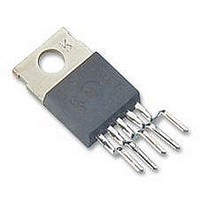LM2595T-ADJ National Semiconductor, LM2595T-ADJ Datasheet - Page 20

LM2595T-ADJ
Manufacturer Part Number
LM2595T-ADJ
Description
DC/DC Converter IC
Manufacturer
National Semiconductor
Datasheet
1.LM2595T-ADJ.pdf
(29 pages)
Specifications of LM2595T-ADJ
Input Voltage
40V
Output Current
1A
Output Voltage
37V
No. Of Pins
5
Termination Type
Through Hole
Mounting Type
Through Hole
Voltage Regulator Type
Buck Switching
Output Current Max
1A
Lead Free Status / RoHS Status
Contains lead / RoHS non-compliant
Available stocks
Company
Part Number
Manufacturer
Quantity
Price
Part Number:
LM2595T-ADJ
Manufacturer:
NS/国半
Quantity:
20 000
Company:
Part Number:
LM2595T-ADJ/NOPB
Manufacturer:
NS
Quantity:
8 784
www.national.com
Application Information
DISCONTINUOUS MODE OPERATION
The selection guide chooses inductor values suitable for
continuous mode operation, but for low current applications
and/or high input voltages, a discontinuous mode design
may be a better choice. It would use an inductor that would
be physically smaller, and would need only one half to one
third the inductance value needed for a continuous mode de-
sign. The peak switch and inductor currents will be higher in
a discontinuous design, but at these low load currents
(400 mA and below), the maximum switch current will still be
less than the switch current limit.
Discontinuous operation can have voltage waveforms that
are considerable different than a continuous design. The out-
put pin (switch) waveform can have some damped sinusoi-
dal ringing present. (See Typical Performance Characteris-
tics photo titled Discontinuous Mode Switching Waveforms)
This ringing is normal for discontinuous operation, and is not
caused by feedback loop instabilities. In discontinuous op-
eration, there is a period of time where neither the switch or
the diode are conducting, and the inductor current has
dropped to zero. During this time, a small amount of energy
can circulate between the inductor and the switch/diode
parasitic capacitance causing this characteristic ringing. Nor-
mally this ringing is not a problem, unless the amplitude be-
comes great enough to exceed the input voltage, and even
then, there is very little energy present to cause damage.
Different inductor types and/or core materials produce differ-
ent amounts of this characteristic ringing. Ferrite core induc-
tors have very little core loss and therefore produce the most
ringing. The higher core loss of powdered iron inductors pro-
duce less ringing. If desired, a series RC could be placed in
parallel with the inductor to dampen the ringing. The com-
puter aided design software Switchers Made Simple (ver-
sion 4.3) will provide all component values for continuous
and discontinuous modes of operation.
OUTPUT VOLTAGE RIPPLE AND TRANSIENTS
The output voltage of a switching power supply operating in
the continuous mode will contain a sawtooth ripple voltage at
the switcher frequency, and may also contain short voltage
spikes at the peaks of the sawtooth waveform.
The output ripple voltage is a function of the inductor saw-
tooth ripple current and the ESR of the output capacitor. A
typical output ripple voltage can range from approximately
0.5% to 3% of the output voltage. To obtain low ripple volt-
age, the ESR of the output capacitor must be low, however,
caution must be exercised when using extremely low ESR
capacitors because they can affect the loop stability, result-
FIGURE 17. Post Ripple Filter Waveform
(Continued)
DS012565-32
20
ing in oscillation problems. If very low output ripple voltage is
needed (less than 20 mV), a post ripple filter is recom-
mended. (See Figure 1 .) The inductance required is typically
between 1 µH and 5 µH, with low DC resistance, to maintain
good load regulation. A low ESR output filter capacitor is also
required to assure good dynamic load response and ripple
reduction. The ESR of this capacitor may be as low as de-
sired, because it is out of the regulator feedback loop. The
photo shown in Figure 17 shows a typical output ripple volt-
age, with and without a post ripple filter.
When observing output ripple with a scope, it is essential
that a short, low inductance scope probe ground connection
be used. Most scope probe manufacturers provide a special
probe terminator which is soldered onto the regulator board,
preferable at the output capacitor. This provides a very short
scope ground thus eliminating the problems associated with
the 3 inch ground lead normally provided with the probe, and
provides a much cleaner and more accurate picture of the
ripple voltage waveform.
The voltage spikes are caused by the fast switching action of
the output switch and the diode, and the parasitic inductance
of the output filter capacitor, and its associated wiring. To
minimize these voltage spikes, the output capacitor should
be designed for switching regulator applications, and the
lead lengths must be kept very short. Wiring inductance,
stray capacitance, as well as the scope probe used to evalu-
ate these transients, all contribute to the amplitude of these
spikes.
When a switching regulator is operating in the continuous
mode, the inductor current waveform ranges from a triangu-
lar to a sawtooth type of waveform (depending on the input
voltage). For a given input and output voltage, the
peak-to-peak amplitude of this inductor current waveform re-
mains constant. As the load current increases or decreases,
the entire sawtooth current waveform also rises and falls.
The average value (or the center) of this current waveform is
equal to the DC load current.
If the load current drops to a low enough level, the bottom of
the sawtooth current waveform will reach zero, and the
switcher will smoothly change from a continuous to a discon-
tinuous mode of operation. Most switcher designs (irregard-
less how large the inductor value is) will be forced to run dis-
continuous if the output is lightly loaded. This is a perfectly
acceptable mode of operation.
In a switching regulator design, knowing the value of the
peak-to-peak inductor ripple current ( I
determining a number of other circuit parameters. Param-
FIGURE 18. Peak-to-Peak Inductor
Ripple Current vs Load Current
IND
) can be useful for
DS012565-33














